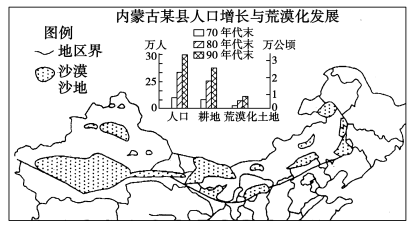问题
选择题
读 “我国西北地区沙地分布及内蒙古某县人口增长与荒漠化发展” 图,完成下列问题。

小题1:据图中信息分析,该县荒漠化不断发展的主要原因是( )
A.气候干旱
B.过度开垦
C.开采矿产
D.水资源的不合理利用小题2:针对我国西北地区荒漠化不断发展的问题,应该采取的整治措施是( )
A.恢复地表植被,退耕还牧
B.实施人工降雨
C.调整农业结构,发展粮食生产
D.发展立体农业
答案
小题1:B
小题2:A
题目分析:
小题1:图中所体现的是人口、耕地与沙漠化面积变化关系图,根据图中信息分析,随着人口不断增长,也不断扩大耕地,耕地面积不断增加,人们过度开垦,导致荒漠化面积不断扩大。所以由图信息可分析,该县荒漠化不断发展的主要原因是过度开垦,B项正确。其他选项图中没有体现。
小题2:荒漠化发展的主要原因是植被的破坏,故治理荒漠化主要采取的措施也从恢复植被入手,A项正确;人工降水只能暂时缓解旱情,不是长久之计,且西北地区本身属于干旱半干旱地区,大气湿度本来就小,过度人工降雨可能会起到反效果,使大气湿度更小更干旱,B错误;西北地区干旱少雨,主要是发展畜牧业,不适宜大力发展种植业进行粮食生产,C项错误;立体农业指地势起伏的高海拔山地、高原地区,农、林、牧业等随自然条件的垂直地带分异,按一定规律由低到高相应呈现多层性、多级利用的垂直变化和立体生产布局特点的一种农业,西北地区水源不足,不利于发展立体农业,且发展立体农业会更不利于植被的恢复。
